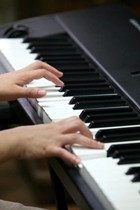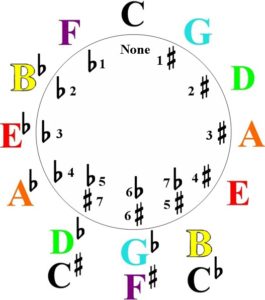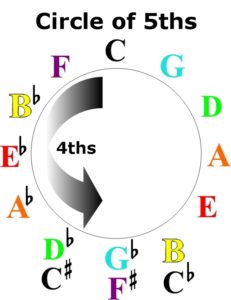The following two tabs change content below.


Greg Lee
Hi, my name is Greg Lee. I'm the creator of the Color Score Professional/Visual Chord Learning System. I love to share ideas and concepts about piano and keyboard playing in all styles of music. I believe the key to learning is having fun and making complicated things simple with visual tools and illustrations.
Latest posts by Greg Lee (see all)
- What is a minor/Major 7 Chord? - October 26, 2023
- 7 Chord Substitutions that Professionals Use - October 19, 2023
- 5 Simple Chord Tricks to Sound Amazing - October 5, 2023


 sound good at the piano. This 11th to 7th Chord Cycle is an excellent tool that you can interject or use as a transition to a target chord.
sound good at the piano. This 11th to 7th Chord Cycle is an excellent tool that you can interject or use as a transition to a target chord. representation of keys, chords, intervals, progressions, etc. In other words, it represents many musical elements.
representation of keys, chords, intervals, progressions, etc. In other words, it represents many musical elements. The flatted 7th tone is located a half step below the 7th tone. By adding it, you have a C7 chord.
The flatted 7th tone is located a half step below the 7th tone. By adding it, you have a C7 chord. In order to transform this C7 chord to a C11, the 3rd is often omitted because it clashes with the 4th (which is referred to as the 11th when a 7th is present).
In order to transform this C7 chord to a C11, the 3rd is often omitted because it clashes with the 4th (which is referred to as the 11th when a 7th is present).
 By playing this 11th chord, your ear will tell you that there's a tension within it that needs to be resolved. That's because the 11th is a suspended tone not unlike those you find in
By playing this 11th chord, your ear will tell you that there's a tension within it that needs to be resolved. That's because the 11th is a suspended tone not unlike those you find in  We want to continue our 11th to 7th chord cycle the smoothest way possible. And as I said before, we're proceeding around the circle of 5ths counter-clockwise. So the next chord is F11. It has the same tones as the C11 we played earlier but a different voicing.
We want to continue our 11th to 7th chord cycle the smoothest way possible. And as I said before, we're proceeding around the circle of 5ths counter-clockwise. So the next chord is F11. It has the same tones as the C11 we played earlier but a different voicing.
 Where would our 11th to 7th chord cycle transition to next? If you know the circle of 5ths (or if you look counter-clockwise on the circle), you can see it's B flat.
Where would our 11th to 7th chord cycle transition to next? If you know the circle of 5ths (or if you look counter-clockwise on the circle), you can see it's B flat.

 to E flat 11
to E flat 11 to E flat 7
to E flat 7 to A flat 11
to A flat 11 to A flat 7
to A flat 7 to D flat 11
to D flat 11 to D flat 7
to D flat 7 to G flat 11
to G flat 11 to G flat 7
to G flat 7 to B11
to B11 to B7
to B7 to E 11
to E 11 to E7
to E7 to A11
to A11 to A7
to A7 to D11
to D11 to D7
to D7 to G11
to G11 to G7
to G7 Back to our starting point at C11.
Back to our starting point at C11.